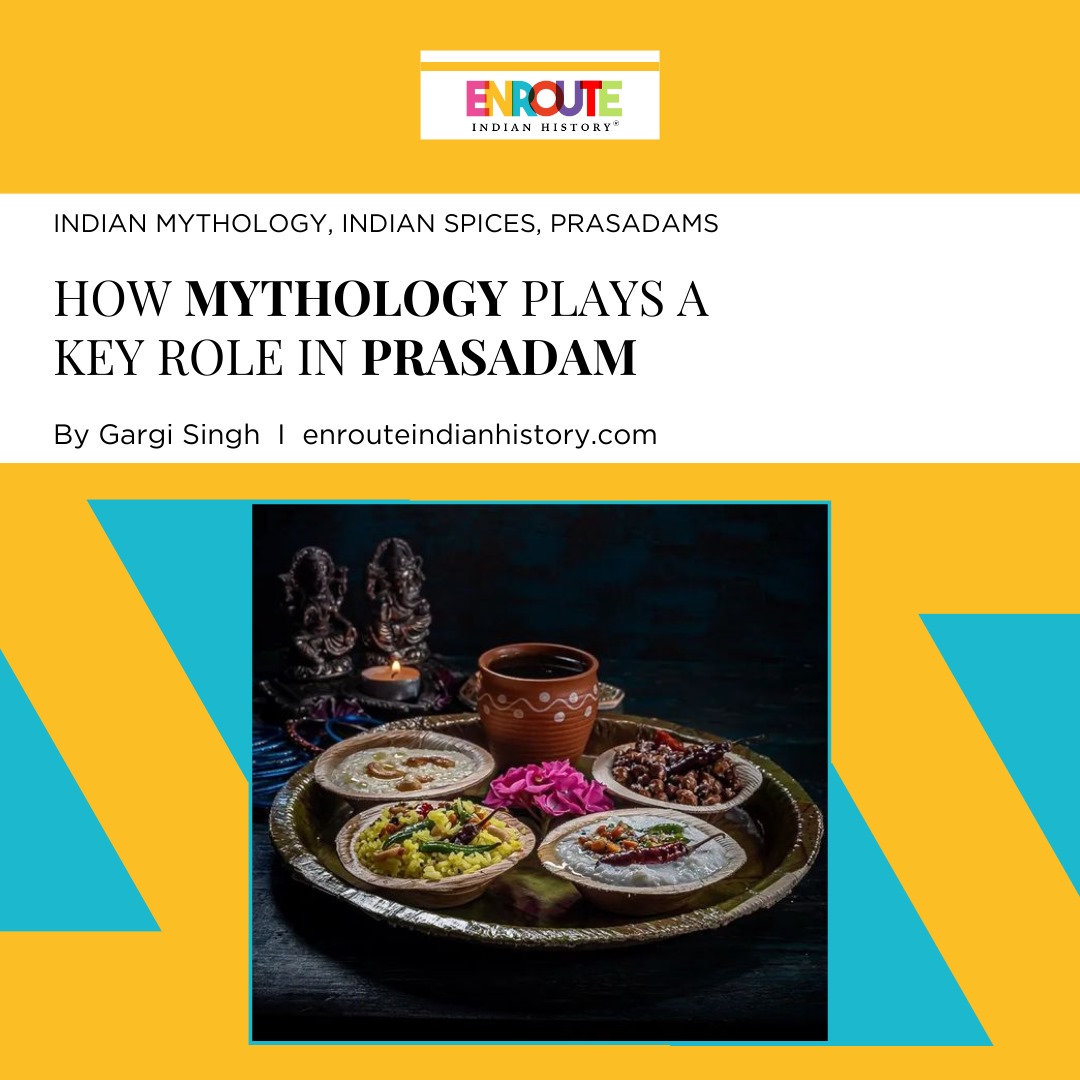
The various spices of India are of exceptional significance in Indian cuisine; however, they fare with the same level of gravity in determining the offering to the deities of India. The significance of Prasadam is specifically important in the Hindu culture of the South Asian Civilizations.
In the Hindu pantheon, the gods resemble humans in their requirement for food, and thus the practice of offering food to gods becomes a perfectly rational routine in the rituals of worship. This act of routine worship of offering food to the deity in temples is referred to as Naivedya. Naturally, the devotee offers dishes that suit the deity’s preferences and characteristics as determined by tradition, but also by the rational practicality and availability in the region.
India is reckoned as the land of spices, and thus inherently in our Prasadams as well, spices are well included. Foods offered to the deity are those that are common to the area and community of the origin of the deity. The properties of the heating and cooling effect of certain foods are well accounted for when offering Prasadams to deities.
The connection between Indian Mythology and Indian culinary habits illuminates a profound cultural and spiritual significance in Indian History. Spices, revered for their medicinal properties and sensory delights, play a pivotal role in shaping the offerings to the divine. Each spice carries symbolic meanings that align with the characteristics and preferences of specific deities, enriching the ritualistic experience of worship and forging a deeper devotee-deity connection in Indian religious and spiritual heritage.
In the tapestry of Indian mythology, spices are embedded with divine attributes, symbolizing purity, strength, and spiritual awakening. From the chilly Chana Sundal for goddesses Lakshmi, Durga, and Saraswati to the cooling Kambukoozh for Lord Subrahmanya or Murukan, spices serve as mediums for invoking the presence and blessings of the divine. Furthermore, the careful selection and preparation of Prasadams, infused with an array of spices, reflect not only regional culinary traditions but also the deep understanding of balancing the body’s energies, known as doshas, by Ayurvedic principles.
Thus, the offering of Prasadam transcends mere culinary rituals, becoming a sacred communion between the devotee and the divine, where spices serve as symbols of devotion and reverence. Through the intrinsic fusion of flavors, textures, and aromas; Prasadams embody the essence of Indian spirituality, weaving together the threads of tradition, mythology, ayurveda, and culinary craftsmanship into the formation of a divine nourishment and blessing for the devotees.
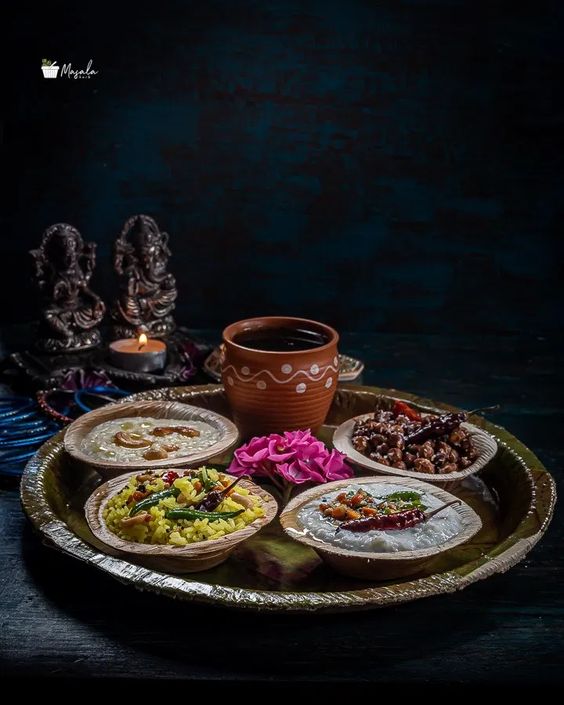
(Source: Padma Veeranki, Masala Korb)
Panchamrit: The elixir of the divine
Consider the relishing elixir, Panchamrit for that matter. ‘Panch’ meaning five and ‘Amrit’ meaning nectar is a concoction of five ingredients namely, milk, yogurt, honey, ghee, and sugar that can be found in almost all Hindu rituals and some festivals of Buddhist and Jaina cultures. Milk having the highest of the sattvic qualities is an essential purifier of the Panchamrit. Its importance cannot be more emphasized when it establishes association with the holy cow. Yogurt or Dahi gain is associated with milk, preservation, purity, and probiotics. Honey or Madhu is one of the important elements mentioned in the Rig Veda, Chandogya Upanishad and Brihadaranyaka Upanishad. It is also directly associated with major gods like Lord Vishnu, Lord Krishna, and Lord Indra with the name Madhav. Ghee or clarified butter, is linked with purity, devotion, and sacred offering in Vedic rituals. It is inclusion to incur the divine blessings of gods for strength, knowledge, and victory. Sugar or Mishri or Jaggery is used in Panchamrit to instill sweetness as against the sourness of yogurt, symbolizing bliss and prosperity.
Considering regional variations in India, there are several modifications in the ingredients of the Panchamrit. Hence, for instance, Cardamom or Elaichi, Basil or Tulsi leaves, Fox Nuts or Makhanas, Raisins, Grated Coconut, Almonds, Cashews, Pistachios, Dried Rose Petals, Ganga Jal/Water and/or Butter, could be added to Panchamrit as per availability and needs. In the puja itself, the ingredients are added to mostly silver, steel, bronze, clay, or mud utensils due to their unreactive properties.
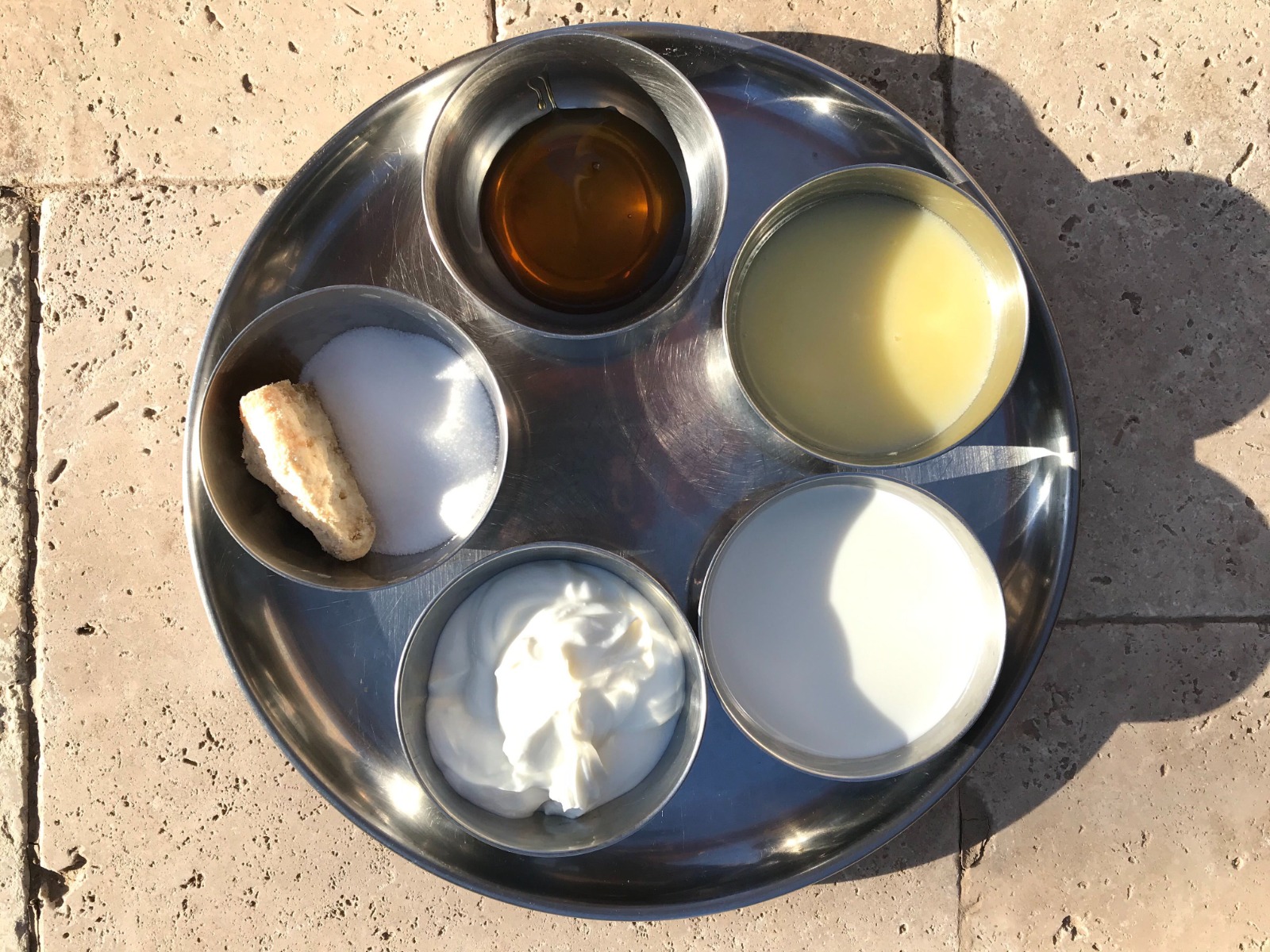
(Source: Vrindavan Lila Devi Dasi, via Wikimedia Commons)
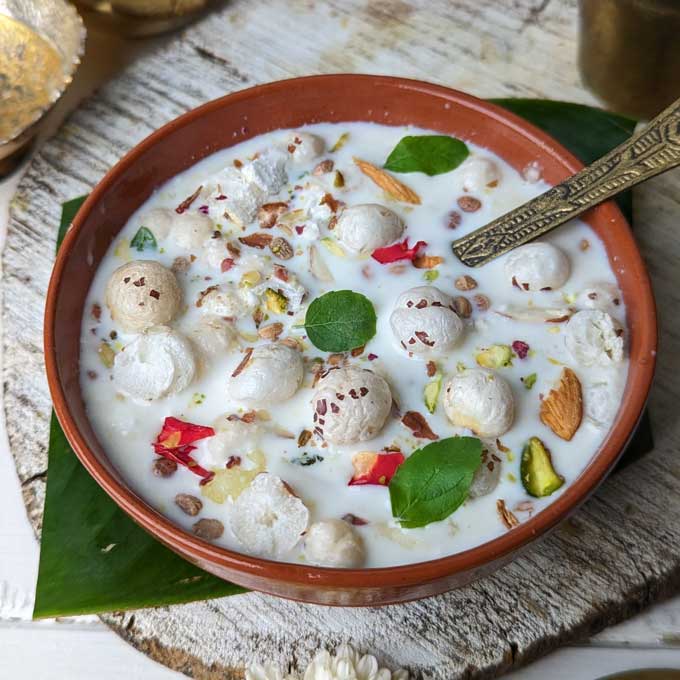
(Source: Hina Gujral, via Fun Food Frolic)
Prasadams, Mythology and Religious Rituals
Prasadams have been an integral part of religious rituals of Indian traditions and the basis of several constructs of Indian Mythology. In the intricate mosaic of Indian religious customs and mythological narratives, prasadams hold a distinguished place, serving as both a symbol of devotion and a modem for spiritual connection. These sacred offerings, deeply intertwined with the rituals of Indian traditions, embody the very essence of divine grace and reciprocity between devotees and deities. Across Indian mythology, prasadams weave threads of significance, their essence intricately woven into the stories of gods and mortals alike, enriching the cultural landscape with their timeless presence and profound symbolism.
Lord Ganesha is offered Modakas, a sweet dumpling made up of coconut and jaggery, and the added cardamom powder for a sweet taste and aroma. Many stories revolve around Lord Vinayak’s insatiable hunger. According to one myth, he had consumed his beloved dish of modakas so much that his belly swelled, and he had to use a snake as a rope to hold it together. However, there are regional variations to the making of this prasadam as well.
In Tamil Nadu, people offer various cakes to Lord Ganesha, collectively known as Korukkattai. These cakes can have sweet or savory fillings, with one specific type called Agamic Modaka. In Karnataka, he is given Kadubu, a sweeter version of the Tamil cake. In Andhra Pradesh, Undrallu is served as sweet balls to the deity, while in Kerala, Ghee Appam, a sweet round cake fried in ghee, is believed to be his preferred treat. In Kerala, to satisfy Lord Ganapati’s appetite, Mudappam Puja is performed, where the idol of the deity is covered with cakes. It is interesting to denote that all his favorite sweets, except appam, are plump and bulging, possibly symbolizing his stout build.
Other prasadams like Payasam (sweet pudding of milk/rice, jaggery, and ghee) as Ayyapa Prasadam of Sabarimala Temple, Sri Vari Laddu (sweet ball of flour, nuts, sugar/jaggery, cardamom, and ghee) of Tirupati Balaji Temple, Makhan Mishri (Freshly churned butter and Sugar candy) at the Banke Bihari and Dwarkadhish Temple, the Mahaprasadam (a full meal of 56 dishes with authentic indigenous vegetables and spices) at the Jagannath Temple, etc. also are symbolic of the revered devotion of the devotees towards their deities and rituals.
In essence, the tradition of offering Prasadam intertwines the realms of mythology, spirituality, and culinary sciences like Ayurveda into a sacred communion between devotees and deities. Through the meticulous selection and preparation of ingredients, embedded with symbolic meanings and regional and temporal variations, Prasadam transcends from mere culinary rituals to becoming a profound expression of devotion and reverence. From the delightful elixir of Panchamrit to the diverse array of sweets and dishes offered to different deities across India, each offering represents a heartfelt tribute to the divine. As devotees partake in these blessed offerings, they not only nourish their bodies but also nourish their souls, forging a deeper connection with the divine essence that permeates every aspect of Indian culture and spirituality. Thus, Prasadam stands as a testament to the rich tapestry of Indian traditions, where spices, flavors, and aromas converge to create a sacred symphony of devotion and blessing.
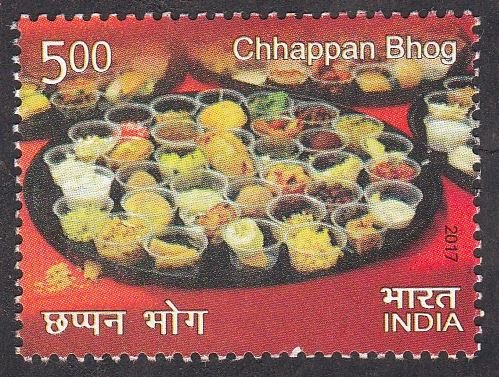
(Source: Post of India, GODL-India, via Wikimedia Commons)
References
Ferro-Luzzi, Gabriella Eichinger. “The Logic of South Indian Food Offerings.” Anthropos (1977).
Gulzar Ahmad Nayik, Tajamul Rouf Shah, Khalid Muzaffar, Sajad Ahmad Wani, Amir Gull, Ishrat Majid and Farhan Mohiudidin Bhat. “Honey: Its History and Religious Significance: A Review.” Universal Journal of Pharmacy (2014).
Pant, Pushpesh. “Food and the Making of the Nation .” India International Centre Quarterly (2013).
Pinkney, Andrea Marion. “Prasāda, the Gracious Gift, in Contemporary and Classical South Asia.” Journal of the American Academy of Religion (2013).



















